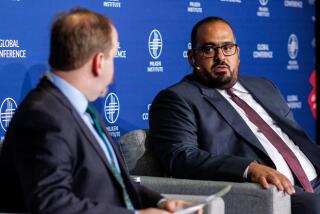Malaysia Looks West to Attract Foreign Investment
- Share via
Malaysia is mounting an aggressive move to reach out to business worldwide. Next year, the country will begin exporting its first car to the United States. And Malaysia’s production lines can’t keep up with the big worldwide demand for their rubber gloves in the wake of AIDS.
The country, which had followed a “look East” policy to emulate the Japanese and Korean work ethic and management systems, is now looking to the West to shore up its economy and provide jobs.
Toward that end, Malaysia recently instituted a series of incentives designed to attract foreign investors.
“We have been too much inward looking,” explained Rafidah Aziz, who became Malaysia’s minister of trade and industry in May. “We have to change that. With this change in attitude, things will change.”
Aziz recently held a two-day seminar in Los Angeles to explain how U.S. firms can capitalize on Malaysia’s “Industrial Master Plan 1986-1995.” She did the same in Chicago and New York.
Other Malaysian officials are doing the same. Dr. Chong Eu Lim, chief minister of the state of Penang, which has been called the Silicon Valley of the East because of its high concentration of U.S. electronic firms, is on a three-week tour through 13 U.S. cities in search of 10 to 15 U.S. firms to invite on a trade mission to Penang.
Malaysia currently is battling its way out of a recession and is attempting to diversify its economy to be less reliant on commodities such as oil, rubber, palm oil, tin and tropical timber, which comprise 70% of the country’s exports.
Gross Product Down
The country is hoping that increased foreign investment will provide better jobs for a large number of returning U.S.-educated professionals who are overqualified for the jobs they’ve had to take during the recession. Malaysia spends $300 million annually to educate 17,000 Malaysian students in the United States.
The country’s gross domestic product had been growing 7% to 8% a year until 1984, when it rose only 4.5% because of a sharp drop in the prices of Malaysia’s commodity exports, according to Ber Keat Gan, trade commissioner at the Los Angeles office of the Consulate General of Malaysia.
In 1985, Malaysia’s gross domestic product fell 1%. It moved back into the black with an increase of 1.5% in 1986 and is expected to be up 3% in 1987.
The Malaysian government is targeting industrial export sectors that are tied to the country’s natural resources. In addition, high technology continues to be a top priority. Penang, for example, is pushing to expand beyond production of semiconductors to include wafer fabrication.
Malaysia has already begun exporting its compact Proton Saga car, a joint venture with Mitsubishi, to New Zealand and plans to add Britain, Taiwan and China as well as the United States. The car was originally developed for the Malaysian domestic market but the recession forced it to seek markets overseas.
To encourage foreign investment in Malaysia, the government has liberalized and added incentives. They include:
Foreign investors can now take a 100% equity interest. Previously foreigners were generally limited to a 51% interest in a Malaysian plant unless 80% of the plant production volume was exported.
Companies accorded “pioneer” status will be exempt from Malaysia’s 40% corporate tax for five years. Pioneer status means a firm is manufacturing goods that the Malaysian government has designated as a product category to promote.
Foreign investors are entitled to an investment tax allowance based on capital investment, excluding real estate, over a five-year period.
More to Read
Inside the business of entertainment
The Wide Shot brings you news, analysis and insights on everything from streaming wars to production — and what it all means for the future.
You may occasionally receive promotional content from the Los Angeles Times.








